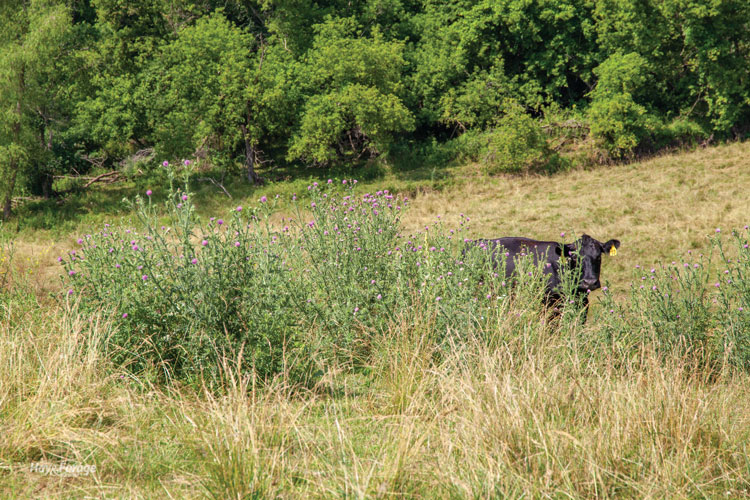The author is an extension beef program specialist with Iowa State University.

As we wrap up the 2023 growing season, it’s easy to focus on other areas of farm and ranch enterprises, but there are still opportunities to make improvements to pastures. Even with high calf prices, we find ourselves looking for options to improve forage production on a budget. Here are three recommendations that have actionable tasks to complete this fall and will start showing a return on investment in the 2024 growing season.
Address soil fertility gaps
When it comes to boosting forage yield, fertilizer quickly comes to mind. However, a “more equals better” mindset can result in more money spent to achieve each additional pound of forage. Rather, to optimize fertilizer benefits, first identify and address limiting nutrients that are needed with a soil sample. Fall is an ideal season to sample soil because it gives producers time to analyze results and draft a fertilization plan before sourcing products. Work with your local extension specialist or agronomist to make a sampling protocol and ensure you select the right analysis package to meet your goals.
Rather than only focusing on nitrogen, prioritize addressing soil pH, followed by phosphorus and potassium. Soil pH is a good starting point because of its impact on nutrient availability. A high, alkaline pH can tie up nutrients like iron and manganese, while a low, acidic pH can tie up other nutrients like sulfur, phosphorus, and potassium. In general, a pH of about 6 is ideal for cool-season grasses while a pH of about 6.5 favors clover or other legumes in mixed pastures. Pure alfalfa stands require soil pH to be even higher. Aim to manage the forage species present as well as desired species.
After identifying what nutrients are needed, determine the nutrient source and if a single or split application is warranted. The optimal fertilizer rate will be impacted not only by the current nutrient level in the soil, but also soil pH, forage species, and production goals. When the limiting nutrient is corrected from low or very low levels and amended to reach optimum levels, forage production can drastically improve, assuming there is adequate moisture. This result is dependent on multiple factors, but getting soil pH, phosphorus, and potassium to the optimum levels is a good first step.
Address unwanted plants
Boosting productivity involves discouraging unwanted species as much as encouraging desirable species. That said, as perennial and biennial weeds enter dormancy in the fall, systemic herbicides can be more effective. Because forage and weeds are preparing for winter dormancy, the applied herbicide will travel with plants’ energy reserves from shoots to the perennial vegetative reproductive structures like rhizomes and roots. This promotes a more consistent result than when herbicides are applied at other times of the year.
When determining if and/or where herbicide use may be warranted, consider weed species as well as weed health. Examples of timely weeds to target in the Midwest from August through October include mustards, Canada thistle, wild parsnip, and poison hemlock. It’s easy to assume less vigorous plants are easier targets, but because the herbicide affects plant energy reserves in the roots, a healthy leaf area will allow better absorption and translocation of the herbicide.
There are other weed control methods that can be done in the fall and may be effective depending on the target species. As always, if utilizing an herbicide, pay special attention to the label for any grazing or haying restrictions. The Crop Data Management Systems (CDMS) label database can be a useful resource to check labels before purchasing a product.
Prepare for interseeding
Interseeding in late summer is an option to thicken thin grass stands, but planting date matters. By now, some parts of the country may be past the window of opportunity to plant this year, but this is a good time to identify and prepare areas for late winter frost seeding or early spring interseeding. To do so, consider factors that impact seedling success, such as seed-to-soil contact, competition with other forages and weeds, and nutrient availability.
This fall, you can implement a grazing strategy that reduces competition between interseeded forages and other grasses by grazing an established stand to a short height. Without following through on the interseeding plan, though, overgrazing can hinder or delay forage production next season. If weeds are an issue in the area and herbicide is the tool of choice, be sure to check the label for the crop rotation window and ensure there is no carryover interference with the grass or legume species to be interseeded.
Always keep long-term goals in mind. Some farmers may find investing in fence and water infrastructure to be the best course of action this fall; however, for operational sustainability, improved pasture utilization, and better forage productivity, it is advantageous to reduce days on feed and manage the largest expense of raising livestock.
This article appeared in the August/September 2023 issue of Hay & Forage Grower on page 27.
Not a subscriber? Click to get the print magazine.

